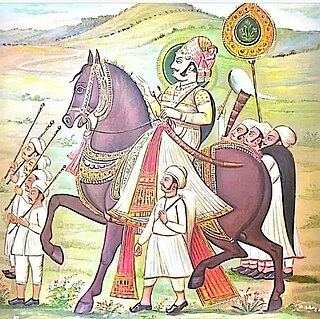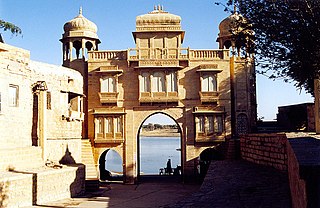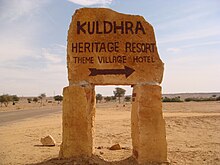
Rajasthan is a state in northwestern India. It covers 342,239 square kilometres (132,139 sq mi) or 10.4 per cent of India's total geographical area. It is the largest Indian state by area and the seventh largest by population. It is on India's northwestern side, where it comprises most of the wide and inhospitable Thar Desert and shares a border with the Pakistani provinces of Punjab to the northwest and Sindh to the west, along the Sutlej-Indus River valley. It is bordered by five other Indian states: Punjab to the north; Haryana and Uttar Pradesh to the northeast; Madhya Pradesh to the southeast; and Gujarat to the southwest. Its geographical location is 23°.3' to 30°.12' North latitude and 69°.30' to 78°.17' East longitude, with the Tropic of Cancer passing through its southernmost tip.

Fatehpur Sikri is a town in the Agra District of Uttar Pradesh, India. Situated 35.7 kilometres (22.2 mi) from the district headquarters of Agra, Fatehpur Sikri itself was founded as the capital of the Mughal Empire in 1571 by Emperor Akbar, serving this role from 1571 to 1585, when Akbar abandoned it due to a campaign in Punjab and was later completely abandoned in 1610.

Jaisalmer, nicknamed "The Golden city", is a city in the Indian state of Rajasthan, located 575 kilometres (357 mi) west of the state capital Jaipur. It is the administrative headquarters of Jaisalmer District. Before Indian independence, the town served as the capital of the Jaisalmer State, ruled by the Bhati Rajputs. Jaisalmer stands on a ridge of yellowish sandstone and is crowned by the ancient Jaisalmer Fort. This fort contains a royal palace and several ornate Jain temples. Many of the houses and temples of both the fort and of the town below are built of finely sculptured yellow sandstone. The town lies in the heart of the Thar Desert and has a population, including the residents of the fort, of about 78,000. Jaisalmer ranked 9th on Booking.com's Top 10 The Most Welcoming cities in the world. It is the only Indian city on the list.

Marwar is a region of western Rajasthan state in North Western India. It lies partly in the Thar Desert. The word 'maru' is Sanskrit for desert. In Rajasthani languages, "wad" means a protected area. English translation of the word 'marwar' is the region protected by desert.

Pali is a city and capital division in Pali district in Indian state of Rajasthan. It is the administrative headquarters of Pali district. It is on the bank of the river Bandi and is 70 km (43 mi) south east of West Jodhpur. It is known as "The Industrial City".

Rajsamand Lake is a lake in the city of Rajsamand in the Rajsamand district of Indian state of Rajasthan, 67 km away from Udaipur. Built by Rana Raj Singh, it is approximately 1.75 miles (2.82 km) wide, 4 miles (6.4 km) long and 60 feet (18 m) deep. It was built across the Gomti river which originates from Sewantri, Kelwa and Tali rivers, with a catchment area of approximately 196 sq mi (510 km2).

The Meghwal or Meghwar people live primarily in northwest India, with a small population in Pakistan. Their traditional occupation was agricultural farming, cattle-herding and weaving. Meghwals are known for their contribution to embroidery and the textile industry. Most are Hindu by religion, with Rishi Megh, Kabir, Ramdev Pir and Bankar Mataji as their chief gods.

Jaisalmer district is the largest district in the Indian state of Rajasthan, and the third largest district in India. Located in Marwar, the city of Jaisalmer is the administrative headquarters of the district. It is around 289 km (180 mi) from the city of Jodhpur, and around 559 km (347 mi) from Jaipur, the capital of Rajasthan. As of the 2011 population census, it is the least populous district out of all 33 districts in Rajasthan.

Jaisalmer Fort is situated in the city of Jaisalmer, in the Indian state of Rajasthan. It is one of the very few "living forts" in the world, as nearly one fourth of the old city's population still resides within the fort. For the better part of its 860-year history, the fort was the city of Jaisalmer. The first settlements outside the fort walls, to accommodate the growing population of Jaisalmer, are said to have come up in the 17th century.

Sundha Mata temple is a nearly 900-year-old temple of Mother goddess Chamunda situated on a hilltop called Sundha, located at Longitude 72.367°E and Latitude 24.833°N, in Jalore District of Rajasthan. It is 64 km (40 mi) from Mount Abu and 20 km (12 mi) from the town of Bhinmal.
Bamnera is a small village situated along the inner margin of the southwestern part of the Thar Desert in the foothills of Aravali mountain range with panoramic landscapes and a few sandy tracks. In more urban geographical terms, it is situated in the Sumerpur tehsil of Pali District in the state of Rajasthan, 12.5 km west of Sheoganj-Sirohi District from Beawar-Radhanpur NH 14.

Rajpurohit is a Brahmin sub-caste residing in South Asia natively in western Rajasthan of India. Their ancestors belonged to family line of SaptRishis. They maintain traditions that are similar to both Brahmins and Rajputs. They have been historically engaged in administration, trading, jagirdar, and as royal council members and warriors and are spread across the entire country. They were given villages at boundary of kingdom. According to political analysts, the Rajput, Charan and Rajpurohit communities are considered to be identical in regards to their social customs and political ideologies.

Kachche Dhaage is a 1999 Indian Hindi-language action thriller film directed by Milan Luthria and starring Ajay Devgn, Saif Ali Khan and Manisha Koirala. The film features Devgan as a smuggler, delivering goods across the Rajasthan-Pakistan border, was filmed in the deserts of Rajasthan and in Switzerland. It premiered on 19 February 1999 in Mumbai.

The history of human settlement in the western Indian state of Rajasthan dates back to about 100,000 years ago. Around 5000 to 2000 BCE many regions of Rajasthan belonged as the site of the Indus Valley Civilization. Kalibangan is the main Indus site of Rajasthan, here fire altars have been discovered, similar to those found at Lothal.

Jaisalmer state is a region of Western Rajasthan state in western India. It lies in the southern part of Thar Desert.

The culture of Rajasthan includes many artistic traditions that reflect the ancient Indian way of life. Rajasthan is also called the "Land of Kings". It has many tourist attractions and facilities for tourists. This historical state of India attracts tourists and vacationers with its rich culture, tradition, heritage and monuments. It also has some wildlife sanctuaries and national parks.
Rajasthani people or Rajasthanis are a group of Indo-Aryan peoples native to Rajasthan, a state in Northern India. Their language, Rajasthani, is a part of the western group of Indo-Aryan languages.
Lanela is a village located in the district of Jaisalmer in the state of Rajasthan in India. It has a population of about 1049 persons living in around 194 households.

Hill Forts of Rajasthan are six forts, spread across Rajasthan state in northern India. They have been clustered as a series and designated as a UNESCO World Heritage Site in 2013. The hill forts series include—Chittor Fort at Chittorgarh, Kumbhalgarh Fort at Rajsamand, Ranthambore Fort at Sawai Madhopur, Gagron Fort at Jhalawar, Amer Fort at Jaipur and Jaisalmer Fort at Jaisalmer.






















